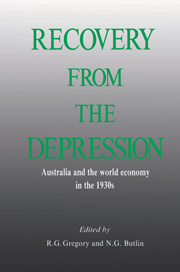Book contents
- Frontmatter
- Contents
- LIST OF AUTHORS
- LIST OF FIGURES
- LIST OF TABLES
- PREFACE
- 1 AN OVERVIEW
- 2 THE AUSTRALIAN RECOVERY OF THE 1930s IN INTERNATIONAL COMPARATIVE PERSPECTIVE
- 3 THE RECOVERY OF THE 1930s AND ECONOMIC POLICY IN BRITAIN
- 4 A MACRO INTERPRETATION OF RECOVERY: AUSTRALIA AND CANADA
- 5 DEPRESSION AND RECOVERY IN NEW ZEALAND
- 6 THE JAPANESE ECONOMY AND ECONOMIC POLICY IN THE 1930s
- 7 THE BATTLE OF THE PLANS: A MACROECONOMETRIC MODEL OF THE INTERWAR ECONOMY
- 8 AUSTRALIAN BUDGETARY POLICIES IN THE 1930s
- 9 MONETARY POLICY IN DEPRESSION AND RECOVERY
- 10 SHARING THE BURDEN: THE AUSTRALIAN LABOUR MARKET DURING THE 1930s
- 11 MANUFACTURING AND ECONOMIC RECOVERY IN AUSTRALIA, 1932–1937
- 12 AGRICULTURE AND THE RECOVERY FROM THE DEPRESSION
- 13 UNEMPLOYMENT AND THE AUSTRALIAN ECONOMIC RECOVERY OF THE 1930s
- 14 GOVERNMENT UNEMPLOYMENT RELIEF IN THE 1930s: AID OR HINDRANCE TO RECOVERY?
- 15 UNEQUAL SACRIFICE: DISTRIBUTIONAL ASPECTS OF DEPRESSION AND RECOVERY IN AUSTRALIA
- REFERENCES
- INDEX
11 - MANUFACTURING AND ECONOMIC RECOVERY IN AUSTRALIA, 1932–1937
Published online by Cambridge University Press: 24 November 2009
- Frontmatter
- Contents
- LIST OF AUTHORS
- LIST OF FIGURES
- LIST OF TABLES
- PREFACE
- 1 AN OVERVIEW
- 2 THE AUSTRALIAN RECOVERY OF THE 1930s IN INTERNATIONAL COMPARATIVE PERSPECTIVE
- 3 THE RECOVERY OF THE 1930s AND ECONOMIC POLICY IN BRITAIN
- 4 A MACRO INTERPRETATION OF RECOVERY: AUSTRALIA AND CANADA
- 5 DEPRESSION AND RECOVERY IN NEW ZEALAND
- 6 THE JAPANESE ECONOMY AND ECONOMIC POLICY IN THE 1930s
- 7 THE BATTLE OF THE PLANS: A MACROECONOMETRIC MODEL OF THE INTERWAR ECONOMY
- 8 AUSTRALIAN BUDGETARY POLICIES IN THE 1930s
- 9 MONETARY POLICY IN DEPRESSION AND RECOVERY
- 10 SHARING THE BURDEN: THE AUSTRALIAN LABOUR MARKET DURING THE 1930s
- 11 MANUFACTURING AND ECONOMIC RECOVERY IN AUSTRALIA, 1932–1937
- 12 AGRICULTURE AND THE RECOVERY FROM THE DEPRESSION
- 13 UNEMPLOYMENT AND THE AUSTRALIAN ECONOMIC RECOVERY OF THE 1930s
- 14 GOVERNMENT UNEMPLOYMENT RELIEF IN THE 1930s: AID OR HINDRANCE TO RECOVERY?
- 15 UNEQUAL SACRIFICE: DISTRIBUTIONAL ASPECTS OF DEPRESSION AND RECOVERY IN AUSTRALIA
- REFERENCES
- INDEX
Summary
Introduction
Manufacturing has taken centre stage in most explanations of Australian economic recovery from the Great Depression of 1929–1932. From Copland, Walker and Giblin on, the rapid emergence of secondary industry as the major employer of Australian labour and the increase in the share of output produced by manufacturing firms has been seen not only as an essential part of recovery but also as the dominant dynamic force, in the process. Nowhere is this proposition stated more clearly than in Schedvin's important and influential study, Australia and the Great Depression:
The dominant structural feature of recovery was the growth in size and importance of the manufacturing sector. … By all available tests, recovery in manufacturing started earlier and proceeded more rapidly than in the rest of the economy. … Just as manufacturing appears to have been the initiating factor in the upturn of 1932, it was the driving force in expansion for the rest of the decade. … Rapid growth of heavy manufacturing was … the main source of recovery in Australia and import replacement reinforced by improvements in efficiency its means (Schedvin 1970a, pp. 291, 301–2, 309).
Australia in the interwar years was a small open economy undergoing industrialization. It is therefore no surprise that manufacturing should have risen in importance throughout this period. The question is whether the growth of manufacturing was shaped by the depression or by policies introduced to cope with it. This chapter suggests that the tariff and devaluation had a much smaller role to play in sponsoring manufacturing growth in the 1930s than is commonly claimed.
- Type
- Chapter
- Information
- Recovery from the DepressionAustralia and the World Economy in the 1930s, pp. 245 - 272Publisher: Cambridge University PressPrint publication year: 1989



